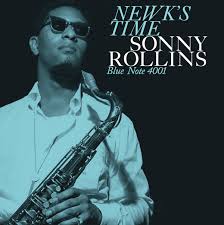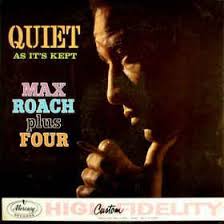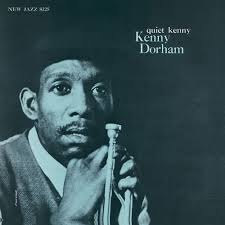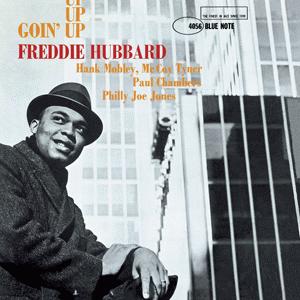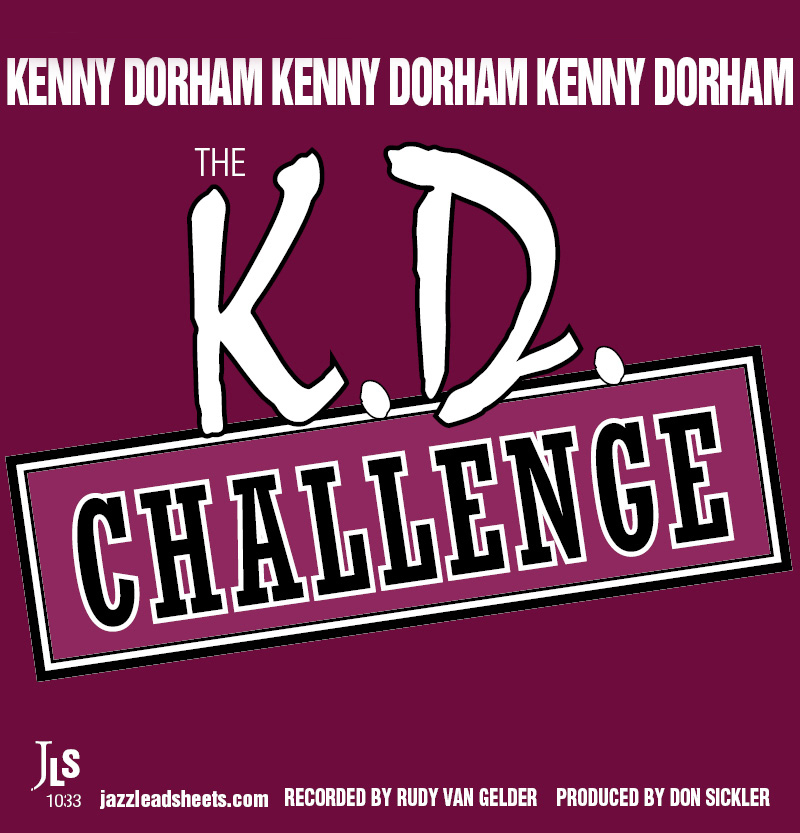Lotus Blossom – Kenny Dorham
An important Kenny Dorham work that he revisited quite a few times, recording it in many different settings and arrangements. We explore the first six recordings (two of them recorded under the title Asiatic Raes); these different treatments show Kenny's inexhaustible inventiveness. We also have Minus You editions from our "K.D. Challenge" version to help you get inside this masterpiece.
- Recording: Sonny Rollins - Newk's Time
- Recorded on: September 22, 1957
- Label: Blue Note (BLP 4001)
- Concert Key: D minor
- Vocal Range: , to
- Style: Latin/swing (medium up)
- Tenor Sax - Sonny Rollins
- Piano - Wynton Kelly
- Bass - Doug Watkins
- Drums - Philly Joe Jones
Video
- Description
- Historical Notes
- Solos
- Piano Corner
- Bass Corner
- Drum Corner
- Guitar Corner
- Inside & Beyond
- Minus You
Another unique feature of this version is the rhythm section hits on the fifth measure of the A and C sections: while most other versions have the hits with the lower notes of the melody starting on the "and" of beat 1, here the hits are with the higher notes and begin on the downbeat. There is no melodic line in the last two measures of the first A section; drums fill in this space instead. Our Concert Condensed Score shows the rhythms of Philly Joe Jones' fills for the in head, as well as some of Sonny's melodic fills on the bridge. The solo changes are the same in all versions; on this recording the first chorus of Sonny's solo is played with a 6/8 Latin feel for the entire chorus, before going to 4/4 swing for the rest of the solos.
This song is titled Asiatic Raes on this recording; interestingly, Freddie Hubbard's recording also uses that title though that version stays in 4/4 for the entire head, contrasting with the Rollins' one. Philly Joe Jones is the drummer on both of these recordings. "Newk's Time" was Sonny Rollins' third album as a leader for Blue Note. This rhythm section combination only recorded together on this album, though Wynton Kelly and Doug Watkins were on two Pepper Adams sessions in November '57 and March '58 with Elvin Jones on drums.
Sonny Rollins and Kenny Dorham were longtime friends and associates. They started recording together on a J.J. Johnson session in 1949. K.D. was next with Sonny Rollins on Sonny's 1954 recording "Movin' Out," which also featured Elmo Hope.
In 1956 and 1957 we were able to count Kenny and Sonny together on eight different session entries in the Lord discography under the leadership of Max Roach, four of which also feature pianist Ray Bryant (they recorded Ray's Minor Trouble). In 1957 they also recorded La Villa for Kenny's "Jazz Contrasts" album. Their last recording together was on October 27, 1957, on an Abbey Lincoln vocal session, with bassist Paul Chambers.
As you'll see, all four of these important artists appear often on jazzleadsheets.com: Sonny Rollins, Wynton Kelly, Doug Watkins and Philly Joe Jones.
Related Songs
Email Send Lotus Blossom to a friend
- Recording: Kenny Dorham - 2 Horns / 2 Rhythm
- Recorded on: November 13, 1957
- Label: Riverside (RLP 12-255)
- Concert Key: D minor
- Vocal Range: , to
- Style: Swing (medium up)
- Trumpet - Kenny Dorham
- Alto Sax - Ernie Henry
- Bass - Eddie Mathias
- Drums - Wilbert Granville T. Hogan
Video
- Description
- Historical Notes
- Solos
- Piano Corner
- Bass Corner
- Drum Corner
- Guitar Corner
- Inside & Beyond
- Minus You
This piano-less quartet recording is the first of the several 4/4 versions. Within this 4/4 adaptation there are two main variations of the second and fourth measure "break" lines of the A and C sections: one with pentatonic lines that rise and fall, and another with mostly descending lines. In the latter the second measure is closer to that of the 6/8 version, while the fourth measure descends similar to a blues scale. This recording uses the first variation for the A sections and the second for the C section.
The horns are largely in unison, harmonized only on the first and third measures of the A and C sections and the second measure of the bridge. The melody contains fills in the last two measures of both A sections and the third and fourth measures of the bridge. Because there is no piano and the bass part on the head consists of rhythmic figures with no walking, our Condensed Score for this version has no chord symbols, only bass note indications (in circles under the staff).
This arrangement is the basis for the two-horn arrangement we use for the out head of our "K.D. Challenge" version. If you need solo changes, you'll find them in this arrangement.
K.D. first recorded with Ernie Henry in 1957, on "Presenting Ernie Henry" for Riverside Records. That session also featured pianist Kenny Drew. (Don Sickler: I'm sure they probably played in big bands together in the late '40s, but I can't find them listed together in any Lord Discography sessions). See other jazzleadsheets.com titles Ernie recorded by typing ERNIE HENRY in the search box top right., then click on the ARTIST/SONGS tab.
The arrangement from this recording formed the basis of a quintet arrangement by jazzleadsheets.com's Don Sickler, recorded by trumpeters Freddie Hubbard and Woody Shaw on the first of their two collaborative albums, "Double Take." This is also the arrangement on most of the out head of our "K.D. Challenge" version; click on the last album cover for more details.
Related Songs
Email Send Lotus Blossom to a friend
- Recording: Barney Wilen - Barney
- Recorded on: April 24-25, 1959
- Label: RCA (430.053)
- Concert Key: D minor
- Vocal Range: , to
- Style: Swing (medium up)
- Trumpet - Kenny Dorham
- Tenor Sax - Barney Wilen
- Piano - Duke Jordan
- Bass - Paul Rovere
- Drums - Daniel Humair
Video
- Description
- Historical Notes
- Solos
- Piano Corner
- Bass Corner
- Drum Corner
- Guitar Corner
- Inside & Beyond
- Minus You
As in the Sonny Rollins version, there is no melodic fill at the end of the first A section; this version is the first whose A section melody ends on the tonic instead of the third (on the first A section only).
Two unique harmonic characteristics here are Dm6 instead of Dsus in the 6/8 sections and the suspension of Gm7 to Dm in the ends of the A and C sections. The out head is in 4/4 for the A sections, going to 6/8 on the first three measures of the C section—this is the same format as the out heads of the "Quiet Kenny" version and our "K.D. Challenge".
We have created a Concert Condensed Score edition for you to explore.
Wilen's album simply titled "Barney" was recorded live at Club Saint-Germain; a second album from these gigs was released on the BMG label.
Related Songs
Email Send Lotus Blossom to a friend
- Recording: Max Roach - Quiet As It's Kept
- Recorded on: July 21, 1959
- Label: Mercury (MG 20491)
- Concert Key: D minor
- Vocal Range: , to
- Style: Swing (uptempo)
- Trumpet - Tommy Turrentine
- Trombone - Julian Priester
- Tenor Sax - Stanley Turrentine
- Bass - Bob Boswell
- Drums - Max Roach
Video
- Description
- Historical Notes
- Solos
- Piano Corner
- Bass Corner
- Drum Corner
- Guitar Corner
- Inside & Beyond
- Minus You
After the in head, there is an interlude (the D section) a la Max—four measures of 5/4 and four measures of 3/4, all with the dotted half note the same length as the whole note in 4/4 as in the 6/8 versions of this song. This section is definitely based on those 6/8 sections, as like most of them it's a vamp alternating Dsus and Csus.
There are three sets of backgrounds for the solos and a shout chorus for the drums, all notated in our Condensed Score. The drum shout chorus, a repeated whole-tone figure, is half of the original tempo. The coda takes the tutti melodic fill from the A section to three long chords and a final unison hit; the last of these chords is played slightly shorter, so it is notated as a dotted half note rather than a whole note, still with a fermata.
We have created a Concert Condensed Score edition for you to explore.
Kenny Dorham played in Max's combo from fall 1956 to spring 1958 when he was replaced by Booker Little. And one must not forget the fiery energy of Tommy Turrentine's trumpet playing.
In addition to their leadership or co-leadership roles, you'll find Max Roach, Julian Priester and Stanley Turrentine on other sessions on jazzleadsheets.com
Related Songs
Email Send Lotus Blossom to a friend
- Recording: Kenny Dorham - Quiet Kenny
- Recorded on: November 13, 1959
- Label: New Jazz (NKLP 8225)
- Concert Key: D minor
- Vocal Range: , to
- Style: Swing (medium up)
- Trumpet - Kenny Dorham
- Piano - Tommy Flanagan
- Bass - Paul Chambers
- Drums - Art Taylor
Video
- Description
- Historical Notes
- Solos
- Piano Corner
- Bass Corner
- Drum Corner
- Guitar Corner
- Inside & Beyond
- Minus You
This version introduces a new stop-time melodic fill for the end of the first A section in both the in and out heads. The piano has a fill in the third and fourth measures of the bridge on the head in, slightly different from the equivalent piano fill in the Barney Wilen version. There is also a drum shout chorus with stop time based on the 4/4 A sections. All these features are included in the "K.D. Challenge" quintet arrangement.
Despite this song's tighter arrangement, the rhythm section on this session takes a freer and more laid-back approach than they did six months earlier on John Coltrane's classic "Giant Steps" album. Tommy Flanagan, Paul Chambers, and Art Taylor first recorded together on a Miles Davis session with Sonny Rollins in March 1956, issued on the album "Collector's Items." They reunited in 1961 on Stanley Turrentine's album "Z.T.'s Blues."
"Quiet Kenny" was K.D.'s only studio album as the sole horn player in a quartet, though there are several live recordings with this instrumentation, mostly from his trips to Europe.
Also check out Blue Spring Shuffle from this session for info about Kenny's first trip to Rudy Van Gelder's newly-built Englewood Cliffs studio.
Of course, you'll find lots of recordings of each member of this classic rhythm section on jazzleadsheets.com: Tommy Flanagan, Paul Chambers and Art Taylor.
Related Songs
Email Send Lotus Blossom to a friend
- Recording: Freddie Hubbard - Goin' Up
- Recorded on: November 6, 1960
- Label: Blue Note (BLP 4056)
- Concert Key: D minor
- Vocal Range: , to
- Style: Swing (medium up)
- Trumpet - Freddie Hubbard
- Tenor Sax - Hank Mobley
- Piano - McCoy Tyner
- Bass - Paul Chambers
- Drums - Philly Joe Jones
Video
- Description
- Historical Notes
- Solos
- Piano Corner
- Bass Corner
- Drum Corner
- Guitar Corner
- Inside & Beyond
- Minus You
Freddie Hubbard's version is in 4/4 throughout. The A section is most similar to the 4/4 A sections of Barney Wilen's version. However, there is a melodic fill at the end of the first A section similar to that of the ""Quiet Kenny" arrangement. Unlike the Barney Wilen arrangement, the A section melody ends on the tonic instead of the third; the horns play in octaves starting on the fourth measure, and the suspension at the end of the second A section is Dsus to D minor. The bridge, uniquely to this version, has a Latin feel; the pickup for the melody is in triplets instead of the usual 8th notes. The end of the head is a two-measure solo break.
This version does not have much of an out head. The last chorus begins as a drum shout, similar to the "Quiet Kenny" version but adding an extra figure to the fifth and sixth measures of the A sections. The bridge is solo drums all the way through, followed by the C section as it was on the in head. This ends in a drum break, which sets up a 6/8 Latin groove with a vamp that fades out to end. This vamp is based on the first measure of the head in 6/8, as in the "Quiet Kenny" version—the piano and bass parts here are the same as the equivalent measure in that arrangement. Yet another way to put the same ingredients together!
We've created a Concert Condensed Score edition for you to explore. As mentioned above, the complete printed quintet arrangement is available from many music dealers.
The title Asiatic Raes was used for this recording as it was for Sonny Rollins' (note that Philly Joe Jones was on both recordings), even though Sonny's is a 6/8 version while this is a 4/4 version. "Goin' Up" was Freddie's second album as a leader; this was the only small group recording with McCoy Tyner and Philly Joe Jones.
McCoy and Philly Joe also accompanied their fellow Philadelphian, trumpeter Lee Morgan, in an 11-piece band on one session for Lee's 1966 album "Delightfulee." In the weeks leading up to the "Goin' Up" session, McCoy recorded on the classic John Coltrane sessions for the albums "Coltrane Plays The Blues," "My Favorite Things" and "Coltrane's Sound."
Freddie would later record this song again, in a quintet arrangement by jazzleadsheets.com's Don Sickler, on the 1985 album "Double Take" co-led with Woody Shaw. This quintet arrangement is a 4/4 version based on "2 Horns/2 Rhythm" and is used for the out head of our "K.D. Challenge" version.
from the Michael Cuscuna "Double Take" liner notes: It was decided early on that this album, which has been in the talking stages for six years through three record labels, be musical and not competitive. Woody Shaw at one point suggested a selection of great compositions by some of the trumpet innovators in jazz. That concept stuck, when after several false starts the project was finally realized on November 21 and 22, 1985.
from Don Sickler: I had the honor of writing the arrangements for this session and for their later album Blue Note album together, The Eternal Triangle
Freddie Hubbard he loved K.D.'s writing and playing, and Freddie told me he was elated when K.D. gave him two songs to record for his "Goin' Up" album (the other one is Karioka). This album was also Freddie's first recording with saxophonist Hank Mobley, with whom he would record again a week later on Hank's classic "Roll Call" album. Freddie and Hank became great friends and would record on several other albums together, including Hank's "The Turnaround" album. Freddie had already recorded on several sessions with bassist Paul Chambers, including Paul's 1959 album "Go" which also features Freddie on Paul's classic composition Ease It.
You can keep up with the ever-growing number of jazzleadsheets.com sessions each of these legendary artists performed on by clicking on their names below, or by typing a name in the top search box that is on every page: Freddie Hubbard / Hank Mobley / McCoy Tyner / Paul Chambers / Philly Joe Jones. Every session shows artistry, mastery of their instruments and commitment to the music.
Related Songs
Email Send Lotus Blossom to a friend
- Recording: Don Sickler - The K.D. Challenge
- Recorded on: October 6, 2001
- Label: jazzleadsheets.com (JLS 1033)
- Concert Key: D minor
- Vocal Range: , to
- Style: Swing (medium up)
- Trumpet - Don Sickler
- Alto Sax - Bobby Porcelli
- Piano - Cecilia Coleman
- Bass - Tim Givens
- Drums - Vince Cherico
Video
- Description
- Historical Notes
- Solos
- Piano Corner
- Bass Corner
- Drum Corner
- Guitar Corner
- Inside & Beyond
- Minus You
CLIPquintet as a quintet arrangement (the basis for our Minus You piano, bass and drums tracks) ;
CLIPquartet123 as a quartet single horn feature (both of these are 6/8 versions),
CLIP841fast and as a faster quartet 4/4 version that features the drums. We'd like to share all three of these with you.
My quintet arrangement and the quartet version are based on K.D.'s quartet "Quiet Kenny" arrangement, which we're calling his 6/8 version of Lotus Blossom. Our quintet track has an alto sax solo followed by piano and bass solos and then goes into the drum shout before the out melody. This master track has been edited to become our Minus You piano, bass and drum tracks.
The piano, bass and drum parts are also the parts for either Kenny's quartet version (where you would add a front line instrument: find your appropriate instrument part) or our Minus You version.
As with other songs in our K.D. Challenge series, we have included the melody on a separate staff in all rhythm section parts. Similarly, melody parts have rhythm section activity indicated under the staff.
The fast 4/4 quartet version featuring the drums is available with a Minus You drums track. This fast drum edition uses the same arrangement as the 4/4 out head on the quintet track. Click on the Drum Corner tab for more details. For the fast 4/4 drum feature version, we have created a separate C treble clef lead sheet edition. We are also providing a Minus You melody track. Melody players can either transpose the C part for their instrument, or, play letter J of the 6/8 arrangement for each A and C section of the 4/4 arrangement.
To play the "Quiet Kenny" 6/8 version yourself as a quartet or expand it to a quintet, you will be able to recognize your part from the listing to your right.
Don Sickler: Our first Lotus Blossom publication was my arrangement for the Freddie Hubbard /Woody Shaw "Double Take" album for Blue Note. This is a 4/4 version arrangement. I was always intrigued with the variety of 6/8 and 4/4 arrangements that Kenny Dorham came up with, and I also wanted to preserve his "Quiet Kenny" format in a quintet arrangement, so in 2001 I came up with my quintet adaptation. At our "K.D. Challenge" session, we also tried a faster 4/4 version CLIP featuring the drums, which is also available (labeled faster 4/4 version MP3 audio track).
Click here to learn more about"The K.D. Challenge" recordings and be sure to check out the rest!
QUINTET First, the master take:
-- intro
-- melody
-- alto sax solo 2 choruses
-- piano solo 2 choruses
-- bass solo 1 chorus
-- drum shout
-- out melody
QUINTET minus Piano
-- intro: bass plays first 4 measures alone (no count off), then drums are added for the next 4, then piano enters for the last 8
-- melody: play figures and comp
-- comp for the alto sax solo 2 choruses
-- solo 2 choruses
-- comp for the bass solo 1 chorus
-- play figures for the drum shout
-- out melody: play figures and comp
QUINTET minus Bass
-- count off sets up the intro
-- play the intro; cymbal hits have been added for the first four measures to lock in the bass figure until the drum groove enters at the 5th measure
play figures and walk for the melody
-- walk for the alto sax and piano solos (2 choruses each)
-- solo one chorus
-- play figures for the drum shout
-- play figures and walk for the out melody
QUINTET minus Drums
-- intro: bass plays first 4 measures alone (no count off), then continue the groove for 12 measures, last 8 are also with piano
-- melody: play figures and comp
-- comp for the alto sax solo (2 choruses), piano solo (2), and bass solo (1)
-- solo around figures for the drum shout
-- out melody: play figures and comp
The second take was 6/8 quartet. and it is also our minus melody track and trio (bass and drums only) track:
QUARTET quartet version
-- intro (no count off)
-- melody
-- 2 trumpet solo choruses
-- out melody
QUARTET minus Melody
-- intro: 16 measures (no count off) bass alone(4) add drums(4), add piano (8)
-- play the melody
-- solo 2 choruses
-- play the out melody
QUARTET Trio: bass & drums only
-- count off (in case you want to experiment over the 16-measure intro)
-- play melody
-- solo 2 choruses
-- play the out melody
At the session, we then tried a fast 4/4 version, featuring the drums:
CLIP master fast 4/4 take
-- intro: (no count off) drums solos for 8 measures
-- trumpet plays melody: trumpet takes break into 8s
-- trumpet trades 8s with drums (1 chorus)
-- drum shout: tutti figures set up drums
-- trumpet plays out melody
Melody instruments can get their fast chops together by playing with the trumpet in the master take, or we have a minus melody take:
FAST minus melody fast 4/4 track
-- intro: (no count off) drums solos for 8 measures
-- play melody, and take the 2 measure solo break
-- trade 8s with drums (1 chorus)
-- play out melody
FAST minus Drums fast 4/4 take-- [downbeat snaps have been added in solo sections]
-- count off followed by downbeat snaps for 8 measure solo
-- melody: play figures and comp. Trumpet takes 2 measure solo break
-- play 8s for one chorus with trumpet (trumpet starts)
-- drum shout: solo around figures
-- trumpet plays out melody: play figures and comp
This track is also great practice for pianists and bassists to lock in with a drummer:
FAST minus piano - Fast Drum Edition in 4/4
-- intro: (no count off) drums solos for 8 measures
-- melody: lock in figures with melody, bass and drums
-- 8s with drums (1 chorus) comp for trumpet 8s
-- drum shout: lock in tutti figures
-- out melody: lock in figures with melody, bass and drums
FAST minus bass - Fast Drum Edition in 4/4
-- intro: (no count off) drums solos for 8 measures
-- melody: lock in figures with melody, piano and drums
-- 8s with drums (1 chorus) walk for trumpet 8s
-- drum shout: lock in tutti figures
-- out melody: lock in figures with melody, piano and drums
Related Songs
Email Send Lotus Blossom to a friend
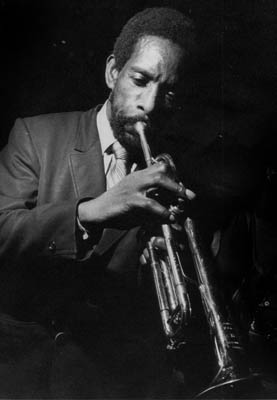
Kenny Dorham
August 30, 1924 – December 15, 1972
August 30, 2025, is Kenny Dorham's 101st birthday: jazzleadsheets.com has added many new K.D. compositions. Jazz At Lincoln Center has dedicated three late-night sets to Kenny's music, played with love by young musicians who want his music to live on. Join in, play K.D. music! Read more...

